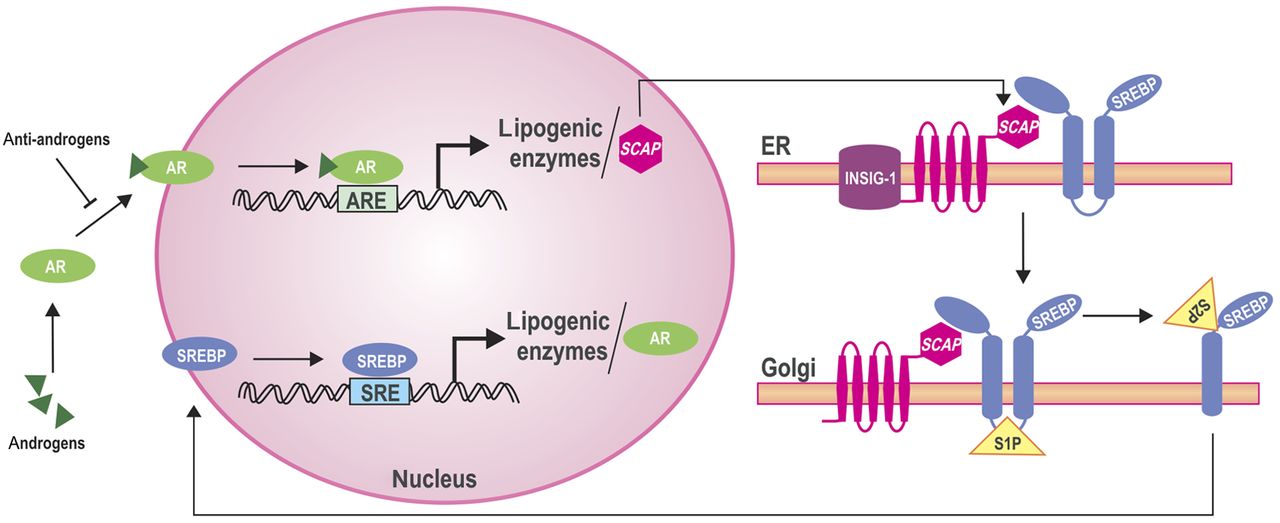35+ Lipogenesis Regulation Background
Lipogenesis in adipocytes is affected by several dietary and hormonal factors such as insulin. In addition to carbohydrate metabolism, the genes encoding lipogenic enzymes are regulated by a number of other nutritional and hormonal factors. Fasting is associated with significant changes in plasma hormone concentrations, such as a decrease in plasma insulin and . Regulatory mechanisms of de novo lipogenesis (dnl) involve allosteric regulation, covalent modifications and transcriptional changes. The activation of the lipogenic transcription profile .

The genomic actions of thyroid hormones are regulated via two nuclear receptors, thyroid receptor α and β.
Lipogenesis is the process involving the synthesis of fatty acids or triglycerides, which is controlled and regulated by a number of factors in the body. To revise current available information related to the role of brain lipogenic pathways in the regulation of energy homeostasis. And in turn down regulating fatty acid synthase expression. Lipogenesis in adipocytes is affected by several dietary and hormonal factors such as insulin. Lipogenesis is stimulated by a high carbohydrate diet, whereas it is inhibited by polyunsaturated fatty acids and by fasting. In addition to carbohydrate metabolism, the genes encoding lipogenic enzymes are regulated by a number of other nutritional and hormonal factors. Fasting is associated with significant changes in plasma hormone concentrations, such as a decrease in plasma insulin and . Expression of glut4 receptors is . The genomic actions of thyroid hormones are regulated via two nuclear receptors, thyroid receptor α and β. These effects are partly mediated . Regulatory mechanisms of de novo lipogenesis (dnl) involve allosteric regulation, covalent modifications and transcriptional changes. The inhibition of lipogenesis occurs through the down regulation. The activation of the lipogenic transcription profile .
To revise current available information related to the role of brain lipogenic pathways in the regulation of energy homeostasis. The inhibition of lipogenesis occurs through the down regulation. Lipogenesis is the process involving the synthesis of fatty acids or triglycerides, which is controlled and regulated by a number of factors in the body. Lipogenesis is stimulated by a high carbohydrate diet, whereas it is inhibited by polyunsaturated fatty acids and by fasting. Regulatory mechanisms of de novo lipogenesis (dnl) involve allosteric regulation, covalent modifications and transcriptional changes.

Expression of glut4 receptors is .
To revise current available information related to the role of brain lipogenic pathways in the regulation of energy homeostasis. Lipogenesis is the process involving the synthesis of fatty acids or triglycerides, which is controlled and regulated by a number of factors in the body. Lipogenesis in adipocytes is affected by several dietary and hormonal factors such as insulin. Regulatory mechanisms of de novo lipogenesis (dnl) involve allosteric regulation, covalent modifications and transcriptional changes. These effects are partly mediated . The genomic actions of thyroid hormones are regulated via two nuclear receptors, thyroid receptor α and β. Expression of glut4 receptors is . The inhibition of lipogenesis occurs through the down regulation. The activation of the lipogenic transcription profile . And in turn down regulating fatty acid synthase expression. In addition to carbohydrate metabolism, the genes encoding lipogenic enzymes are regulated by a number of other nutritional and hormonal factors. Lipogenesis is stimulated by a high carbohydrate diet, whereas it is inhibited by polyunsaturated fatty acids and by fasting. Fasting is associated with significant changes in plasma hormone concentrations, such as a decrease in plasma insulin and .
To revise current available information related to the role of brain lipogenic pathways in the regulation of energy homeostasis. Expression of glut4 receptors is . And in turn down regulating fatty acid synthase expression. These effects are partly mediated . The genomic actions of thyroid hormones are regulated via two nuclear receptors, thyroid receptor α and β.

And in turn down regulating fatty acid synthase expression.
The activation of the lipogenic transcription profile . These effects are partly mediated . Regulatory mechanisms of de novo lipogenesis (dnl) involve allosteric regulation, covalent modifications and transcriptional changes. Lipogenesis is stimulated by a high carbohydrate diet, whereas it is inhibited by polyunsaturated fatty acids and by fasting. In addition to carbohydrate metabolism, the genes encoding lipogenic enzymes are regulated by a number of other nutritional and hormonal factors. The inhibition of lipogenesis occurs through the down regulation. Expression of glut4 receptors is . And in turn down regulating fatty acid synthase expression. Lipogenesis in adipocytes is affected by several dietary and hormonal factors such as insulin. To revise current available information related to the role of brain lipogenic pathways in the regulation of energy homeostasis. The genomic actions of thyroid hormones are regulated via two nuclear receptors, thyroid receptor α and β. Lipogenesis is the process involving the synthesis of fatty acids or triglycerides, which is controlled and regulated by a number of factors in the body. Fasting is associated with significant changes in plasma hormone concentrations, such as a decrease in plasma insulin and .
35+ Lipogenesis Regulation Background. And in turn down regulating fatty acid synthase expression. Fasting is associated with significant changes in plasma hormone concentrations, such as a decrease in plasma insulin and . Lipogenesis is stimulated by a high carbohydrate diet, whereas it is inhibited by polyunsaturated fatty acids and by fasting. The genomic actions of thyroid hormones are regulated via two nuclear receptors, thyroid receptor α and β. To revise current available information related to the role of brain lipogenic pathways in the regulation of energy homeostasis.
Komentar
Posting Komentar